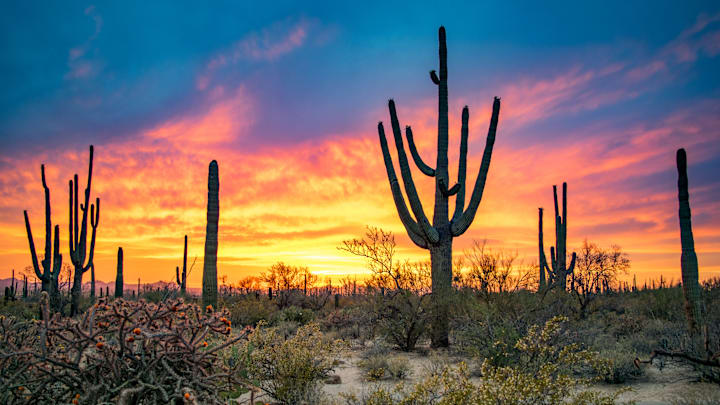No matter where you are in the world, it's hard not to be dazzled by the sun's final display of the day. Sunsets are so celebrated for their natural beauty that pointing it out has become a cliché. Watching the sun disappear beneath the horizon may be a universal experience, but not everyone is treated to the same show. If you've ever watched the sun set in the desert, you may have noticed more spectacular colors than sunsets produced elsewhere.
As Atlas Obscura explains, sunlight contains all shades of the color spectrum. When the sun is high in the sky, these colors blend together to appear white to our eyes. As the sun sinks lower, its rays have to penetrate a thicker layer of atmosphere before they can reach us. Shorter wavelengths of light—such as purples and blues—are scattered by the atmosphere before we can see them. This leaves the longer red and orange wavelengths to stand out.
The natural filter of the atmosphere can create an explosion of rosy shades, but sunsets look different when too much light is blocked. In urban environments, air pollution can dull colors that would be vibrant otherwise. This partly explains why desert sunsets are prized for their beauty. Deserts tend to be sparsely populated, and the clean air allows the sun's vivid colors to shine through at twilight.
The lack of moisture in desert air also contributes to this phenomenon. Like air pollution, water vapor and puffy, rain-gorged clouds can mute the sunset's brilliant hues. Precipitation is rare in dry desert environments, where thin, wispy clouds hang in the mid- to upper levels of the atmosphere. These clouds filter and reflect sunlight rather than blocking it, turning the western half of the sky into a watercolor masterpiece in the evening.
Some people travel out of their way to snap the perfect sunset picture. If you're looking to visit a part of the world that's famously photogenic at dusk, consider one of these popular sunset destinations.
[h/t Atlas Obscura]
